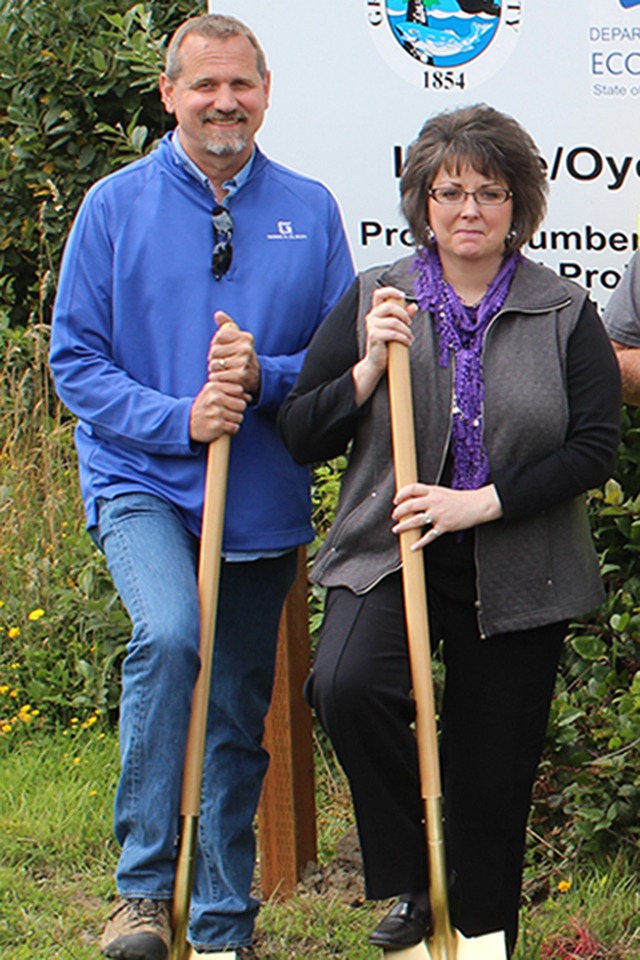MOCLIPS — Grays Harbor County officials met with about 55 disgruntled North Beach citizens last week and promised to review water and sewer rate changes that resulted in bills some say more than doubled since the new rates went into effect in July.
County Commissioner Vickie Raines, who represents District 3, addressed the complaints after a group of property owners and businesses in Water District 3 protested to the county and questioned if the rate increase had been approved in an open public process. Raines was accompanied by Mark Cox, county Facilities and Utilities director, and consultant Mike Olden of Gibbs and Olson engineers.
The increase in rates was approved by County Commissioners in May, Raines said.
Since then, the county discovered there was a discrepancy in the ordinance, she noted.
“So we have gone back, and after hearing concerns from individuals like yourselves and others, we have decided to take a step back and look at the whole idea with a broader brush,” Raines said.
The commissioners, she added, will be considering a proposal to amend the way the rates were calculated, and she vowed the county would look at any individual situation on a case-by-case basis.
“Then it will be up to the commission to make a change and make revisions to the water rates,” Raines said.
She did not, however, promise there would be rebates.
The county officials passed out a proposal dated Oct. 26 that explained the purpose of the original rate/policy changes:
• Establish rates and charges for the new sewer utility in the Illahee/Oyehut area.
• Provide a tiered water rate structure to meet Department of Health water use efficiency planning directives.
• Increase the base rate revenue to keep up with rising maintenance/replacement costs and regulatory requirements (a $1 per month base rate increase equal to about 2.5 percent).
• Increase the base rate for customers with grinder pumps to provide rate equity with ratepayers that do not need grinder pumps. Grinder pumps have a higher overall maintenance and equipment replacement cost.
• Establish a commodity base rate for commercial sewer customers, an increase of between 2-3 percent.
Some of the issues with the new rates, however, were the users with multiple dwellings on a single meter were charged a base rate for each dwelling unit. That was the case in Seabrook, where carriage houses “are a unique circumstance since most of the units are less than 500 square feet and do not typically have full kitchens,” the county proposal said.
Another issue: “Because there was no base commodity allowance for commercial customers, commercial users with low use and moderate sewage characteristics ended up with disproportional charges for service.”
Some of the customers were charged a double rate for so-called ERUs or Equivalent Residential Units. The county maintains three customer classes: residential, hotel/motel, and commercial. Residential customers include “any dwelling unit that can sustain full-time independent living facilities,” and can include homes, cabins, condominium units, townhouses and apartments, as well as non-commercial RV use.
Olden acknowledged that one of the consequences was that a number of Seabrook owners were billed double for the their sewer bills: “Obviously, that becomes a big issue when all of a sudden your sewer bill actually doubles.”
“I think the ERU rate is something we will be willing to take a look at,” Raines promised the citizens, who came from Hogans Corner, the Illahee/Oyehut area, Copalis Beach, Seabrook, Pacific Beach and Moclips, among other areas of the North Beach.
Some of the proposed changes to the rates include the following:
• Set a size qualification for an accessory dwelling unit at 600 square feet to establish a basis for when multiple base rate units are charged on a residential service.
• Establish a residential sewer commodity charge to address rate equity issues between low and high users.
• Establish a base commodity of 600 cubic feet for all sewer customers.
• Adjust commercial base rates to equal residential base rates; and adjust the tiered water commodity allowance to 500 cubic feet and 1,000 cubic feet to alleviate some of the rate burden on above-average water users.
“There are going to be some situations that don’t fall into any of these categories,” Cox noted of the proposed changes. “We’re willing to work with people on a case-by-case basis.”
Smaller commercial users ended up seeing a “pretty disproportional charge” under the new rates, Olden acknowledged.
“So we went back and did some additional data analysis, took at look at last year’s bills for Pacific Beach to figure out in more detail how much people were using … and came up with some strategies to try to create more equity and keep everybody paying the same base rate if you are around the average use,” Olden said of the effort to respond to citizen concern.
Average annual use in Pacific Beach is about 100 gallons of water per day, Olden said. In comparison, 600 cubic feet per month equals about 150 gallons per day, he said.
Many of the citizens said they were not notified of the charges or did not see any notification until they noticed the higher bills in July. A public hearing was held on the rate increases last spring, but it was at county offices in Montesano and not advertised locally on the North Beach.
“Some of that falls on me,” Olden said. “Ideally, this rate increase was supposed to be a simple 2.5 percent base increase for everybody, and ended up being a fiasco on a couple of fronts.”
“Rate setting is not an exact science, and some equity issuess will arise from time to time,” according to the proposal. Raines said she expected the proposed changes to the rates would be presented to the full County Commission on Nov. 7 in its regular meeting.



